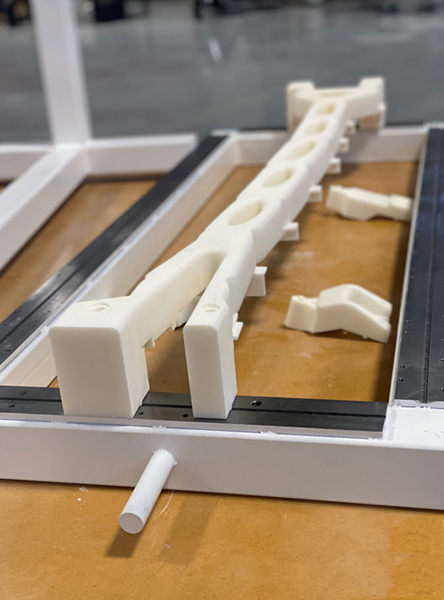
Companies will be more sustainable and decrease their global footprint, which has led businesses to new opportunities and a chance to adjust their priorities. Image courtesy of Skydex.
Latest News
April 30, 2021
Continuous digital tool introduction has catapulted engineering design forward. Such a trend is compounded with modern technologies such as 3D printing and new fabrication methods.
Compound this with other progress made in the development of materials and material science, and remarkable things can happen.
The characteristics of materials change daily. However, the new frontier of mechanical design and rapid prototyping is at a pivotal moment. Products may be designed with great precision, and with very precise properties. These advancements help produce high-performing products that are easier to design, easier to fabricate and that can positively impact those who used them.
Material Importance
Numerous perspectives on new materials are now available for engineering design and used in manufacturing. Such materials include new plastics and composite materials that are emerging that offer many benefits to designers and end users. Many may be used within the scope of 3D printing and additive manufacturing (AM), for industries such as automotive, aerospace, medical, defense, oil and gas, robotics and other industries.

Brandon Ribic is the technology director at America Makes, a proponent of the U.S. additive manufacturing, technology and additive manufacturing education ecosystem.
“What I am hearing is less about new materials than the new application of existing material solutions, which effectively address a need in various industries—automotive, aerospace, defense,” says Ribic. “The benefits may include enabling lower low-cost customization, lower cost tooling or brackets, shorter lead time or even performance improvement.
“Most of our efforts at America Makes have successfully demonstrated significant lead time reduction due to the production of low criticality polymer and composite components for aerospace applications. In addition, [there is] the ability to tailor patient specific orthoses through AM processes using polymer and composite materials,” he adds.
Polymer and composite materials are being used more widely as their properties and functionality are becoming suitable to many applications and uses. Peter Foley is the executive vice president and chief technology officer at Skydex, a company focused on advanced impact mitigation and energy absorption solutions. He touts the benefits of foam, for example, as an engineered material with many uses.
“Foam is how many industries have historically dealt with impact, cushioning or vibration challenges,” says Foley. “And if you pull a piece of foam off the shelf and it does not meet your needs, unfortunately, you either have to use a thicker piece of it or a denser piece of it. As it relates to emerging trends, for example, at Skydex we use a more modern approach with geometries that we engineer to very precisely solve impact and cushioning problems—especially for the military and defense community.”

Materials science and engineering has advanced much recently. But its advancement has been catalyzed with the advent of 3D printing and additive manufacturing, along with digital technologies that ferret out the precise properties and characteristics needed to achieve the desired specifications.
This means manufacturers are demanding composites and materials with different requirements to be lightweight, durable, sustainable, less costly and complementary to other materials.
“We have seen an international industry effort to move in the direction of sustainable products,” says Foley of Skydex. “Whether it’s B2B [business to business] or B2C [business to consumer], there is an expectation that companies will be more sustainable and decrease their global footprint, which has led businesses to new opportunities and a chance to adjust their priorities.”
Foley adds that there is also an increasing demand for more customized solutions. He says that this requires a tremendous effort behind the scenes to make plastics that could be reused, recycled and reclaimed.
“For example, at Skydex, instead of adding a second material we add a geometry to add a property,” Foley adds. “That material can then be reclaimed, reground and put back into the polymer stream easier than a composite material.”
Reverse Engineering Parts for Convenience
Though mechanical design is often pictured as fulfilling a proverbial mission of moving forward with new products, engineers are often called on to move backwards, and recreate old products.
Engineers must often find solutions for parts and designs no longer supported or available. Along with all the numerous challenges that have always faced those in need of spare parts, obsolescence remains a problem. The compatibility and characteristics of materials bring solutions to parts obsolescence.
A part may have been manufactured long ago, but the manufacturer is no longer in business, does not produce the part and maintain spares of a sought after part or was acquired by another firm and their business model changed. This leaves the burden of producing a new one to those who need it. The required part must be reverse-engineered to achieve the same functionality as the original part. Digital technology is helping this effort.
Teton Simulation uses simulation software to reverse engineer parts and extract their strength and load characteristics to recreate them using 3D printing. This is useful for rapid prototyping in that an existing part needs to be recreated.
Their simulation application, Smart Slice, is a technology solution that may be embedded within commercial slicing programs. It employs the fused filament fabrication (FFF) additive manufacturing process. This combines with an algorithm that is physics-based and can validate the structural performance of prototyped parts, and extract from those being replicated. Using optimization algorithms, it provides the precise printer settings for a given feedstock, so that printed parts meet the stiffness and strength requirements of the part. In addition, it optimizes printing time and material used.
“Fiber-reinforced polymers seem to be prevalent for AM along with ABS [acrylonitrile butadiene styrene], TPU [thermoplastic polyurethane], Nylon, PETG [polyethylene terephthalate glycol-modified], PLA [polylactic acid], PEKK [polyetherketoneketone], PEEK [polyetheretherketone] and PEI [polyethylenimine] polymers,” says America Makes’ Ribic.
“There are many AM processing conditions which impact material properties and product performance,” Ribic adds. “Designers should be aware of the finished product requirements and design intent. During [the] product manufacturing process and material selection, these requirements will be critical to ensure the final product will meet the end customer’s needs.”
Manufacturing Self-Sufficiency
In addition to part supply, digital technologies such as Teton Simulation’s Smart Slice serve as a boon to manufacturing self-sufficiency. Should a part’s strength, stiffness and material characteristics be known and scanned, and other digital data archived, the part can be printed as needed.
This offers obvious benefits to a supply chain, where one incidental part—no matter how big or small—may serve as the critical path to moving forward in any capacity. With smarter technology tools that accelerate reverse engineering, this risk is reduced, if not eliminated.
“The supply chain process stands to benefit from better engineered materials and properties that offer an extended life cycle and our unique technologies last longer than the traditional materials they replace,” says Skydex’ Foley. “Designing adaptable materials that can accommodate a variety of tasks will ultimately impact the supply chain in a positive manner. We believe that designing original parts to last an order of magnitude longer eliminates the need for spares or replacement parts, which leads to another avenue for maintaining sustainable business practices.”
Terry Hill is the CEO of Rapid Application Group, an engineering and AM company centered on AM technology. He notes the unprecedented contribution of AM to self-sufficiency.

“Additive manufacturing yields rapid prototyping, high levels of customization, complex designs and the ability to take advantage of lights-out manufacturing,” Hill says. “The mechanical properties and characteristics can be controlled when combined with the proper material selection and specific technology.”
Hill says engineers now can design a part in free space; they are no longer constrained to subtractive or legacy methods of manufacturing composite parts.
“We also use additive manufacturing that enables rapid tooling for composite layup tools,” Hill says. “The mechanical properties of current developed additive manufacturing material allow for autoclaving and low coefficient of thermal expansion.”

Future of Materials and Digital Thread
Digitization and materials science may collaborate more than ever. Advancements in software and digital engineering applications increasingly are playing a critical role in the outcome of mechanical design, and the materials used to produce them.
“The ability to manufacture a spare part from a digital thread is where we are seeing the future of manufacturing,” Hill says. “The material properties of 3D printed parts become increasingly important as a project matures from concept to production. It is the combination of material selection combined with AM technology that will dictate the final characteristics.”
Management consultancy firm McKinsey & Company points out that a technology strategy, amid an ocean of new digital technologies, must collaborate with an overall business strategy. This should synchronize with material selections and considerations, as businesses plan with engineering finesse approach their own ecosystem smartly.
“The first step is a clear articulation of the company’s desired future state, which is linked to business strategy and goals rather than the technology with the greatest buzz. Selection of use cases for pilots is based on a favorable business case, to be refined as the pilots are implemented,” McKinsey states in a report titled, “Industry 4.0: Reimagining manufacturing operations after COVID-19”.
“Outlining a clear business case becomes more complicated when expanding beyond the four walls of the factory but is even more important,” the report states.
More America Makes Coverage

Subscribe to our FREE magazine, FREE email newsletters or both!
Latest News
About the Author
Jim Romeo is a freelance writer based in Chesapeake, VA. Send e-mail about this article to DE-Editors@digitaleng.news.
Follow DE






